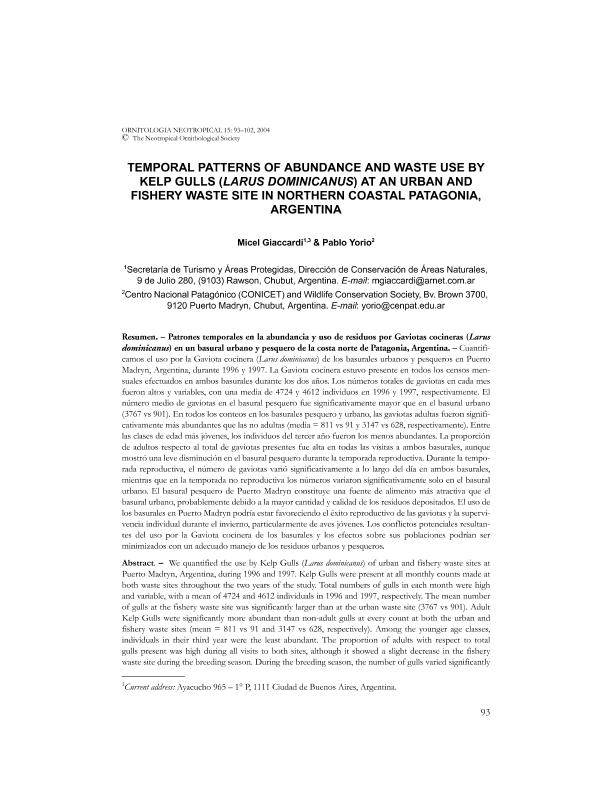Mostrar el registro sencillo del ítem
dc.contributor.author
Giaccardi, Micel

dc.contributor.author
Yorio, Pablo Martin

dc.date.available
2017-12-13T14:16:47Z
dc.date.issued
2004
dc.identifier.citation
Giaccardi, Micel; Yorio, Pablo Martin; Temporal patterns of abundance and waste use by Kelp Gulls at a urban and fishery waste tip in northern coastal Patagonia, Argentina; Neotropical Ornithological Society; Ornitologia Neotropical; 15; 1; 2004; 93-102
dc.identifier.issn
1075-4377
dc.identifier.uri
http://hdl.handle.net/11336/30383
dc.description.abstract
We quantified the use by Kelp Gulls (Larus dominicanus) of urban and fishery waste sites at Puerto Madryn, Argentina, during 1996 and 1997. Kelp Gulls were present at all monthly counts made at both waste sites throughout the two years of the study. Total numbers of gulls in each month were high and variable, with a mean of 4724 and 4612 individuals in 1996 and 1997, respectively. The mean number of gulls at the fishery waste site was significantly larger than at the urban waste site (3767 vs 901). Adult Kelp Gulls were significantly more abundant than non-adult gulls at every count at both the urban and fishery waste sites (mean = 811 vs 91 and 3147 vs 628, respectively). Among the younger age classes, individuals in their third year were the least abundant. The proportion of adults with respect to total gulls present was high during all visits to both sites, although it showed a slight decrease in the fishery waste site during the breeding season. During the breeding season, the number of gulls varied significantly throughout the day at both sites while, during the non-breeding season, numbers varied significantly only in the urban waste site. The Puerto Madryn fishery waste site constitutes a more attractive food source than the urban waste site probably due to the higher quality and quantity of discarded food. The use of waste sites at Puerto Madryn may be enhancing gull breeding success and individual survival during the winter, particularly of young birds. Potential conflicts due to Kelp Gull use of waste sites and the effects on their populations could be minimized by adequate urban and fish waste management
dc.description.abstract
Cuantificamos el uso por la Gaviota cocinera (Larus dominicanus) de los basurales urbanos y pesqueros en Puerto Madryn, Argentina, durante 1996 y 1997. La Gaviota cocinera estuvo presente en todos los censos mensuales efectuados en ambos basurales durante los dos años. Los números totales de gaviotas en cada mes fueron altos y variables, con una media de 4724 y 4612 individuos en 1996 y 1997, respectivamente. El número medio de gaviotas en el basural pesquero fue significativamente mayor que en el basural urbano (3767 vs 901). En todos los conteos en los basurales pesquero y urbano, las gaviotas adultas fueron significativamente más abundantes que las no adultas (media = 811 vs 91 y 3147 vs 628, respectivamente). Entre las clases de edad más jóvenes, los individuos del tercer año fueron los menos abundantes. La proporción de adultos respecto al total de gaviotas presentes fue alta en todas las visitas a ambos basurales, aunque mostró una leve disminución en el basural pesquero durante la temporada reproductiva. Durante la temporada reproductiva, el número de gaviotas varió significativamente a lo largo del día en ambos basurales, mientras que en la temporada no reproductiva los números variaron significativamente solo en el basural urbano. El basural pesquero de Puerto Madryn constituye una fuente de alimento más atractiva que el basural urbano, probablemente debido a la mayor cantidad y calidad de los residuos depositados. El uso de los basurales en Puerto Madryn podría estar favoreciendo el éxito reproductivo de las gaviotas y la supervivencia individual durante el invierno, particularmente de aves jóvenes. Los conflictos potenciales resultantes del uso por la Gaviota cocinera de los basurales y los efectos sobre sus poblaciones podrían ser minimizados con un adecuado manejo de los residuos urbanos y pesqueros
dc.format
application/pdf
dc.language.iso
eng
dc.publisher
Neotropical Ornithological Society

dc.rights
info:eu-repo/semantics/openAccess
dc.rights.uri
https://creativecommons.org/licenses/by-nc-sa/2.5/ar/
dc.subject
Waste Sites
dc.subject
Feeding
dc.subject
Kelp Gull
dc.subject
Larus Dominicanus
dc.subject
Patagonia
dc.subject.classification
Otras Ciencias Biológicas

dc.subject.classification
Ciencias Biológicas

dc.subject.classification
CIENCIAS NATURALES Y EXACTAS

dc.title
Temporal patterns of abundance and waste use by Kelp Gulls at a urban and fishery waste tip in northern coastal Patagonia, Argentina
dc.title
Patrones temporales en la abundancia y uso de residuos por Gaviotas cocineras (Larus dominicanus) en un basural urbano y pesquero de la costa norte de Patagonia, Argentina
dc.type
info:eu-repo/semantics/article
dc.type
info:ar-repo/semantics/artículo
dc.type
info:eu-repo/semantics/publishedVersion
dc.date.updated
2017-11-24T14:33:16Z
dc.journal.volume
15
dc.journal.number
1
dc.journal.pagination
93-102
dc.journal.pais
Estados Unidos

dc.description.fil
Fil: Giaccardi, Micel. Secretaría de Turismo y Áreas Protegidas; Argentina
dc.description.fil
Fil: Yorio, Pablo Martin. Consejo Nacional de Investigaciones Científicas y Técnicas. Centro Nacional Patagónico; Argentina. Wildlife Conservation Society; Estados Unidos
dc.journal.title
Ornitologia Neotropical

dc.relation.alternativeid
info:eu-repo/semantics/altIdentifier/url/https://sora.unm.edu/node/119564
Archivos asociados
